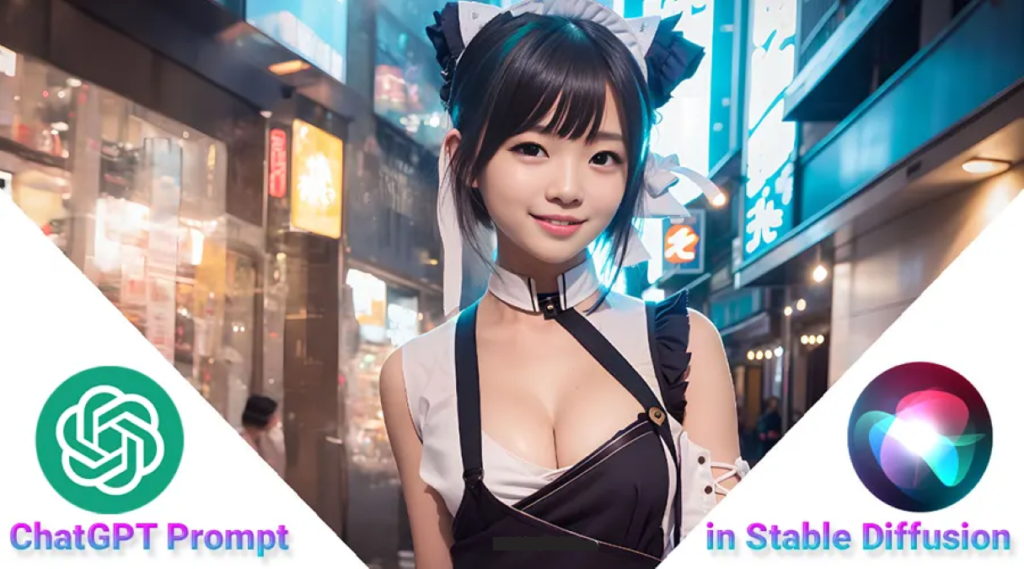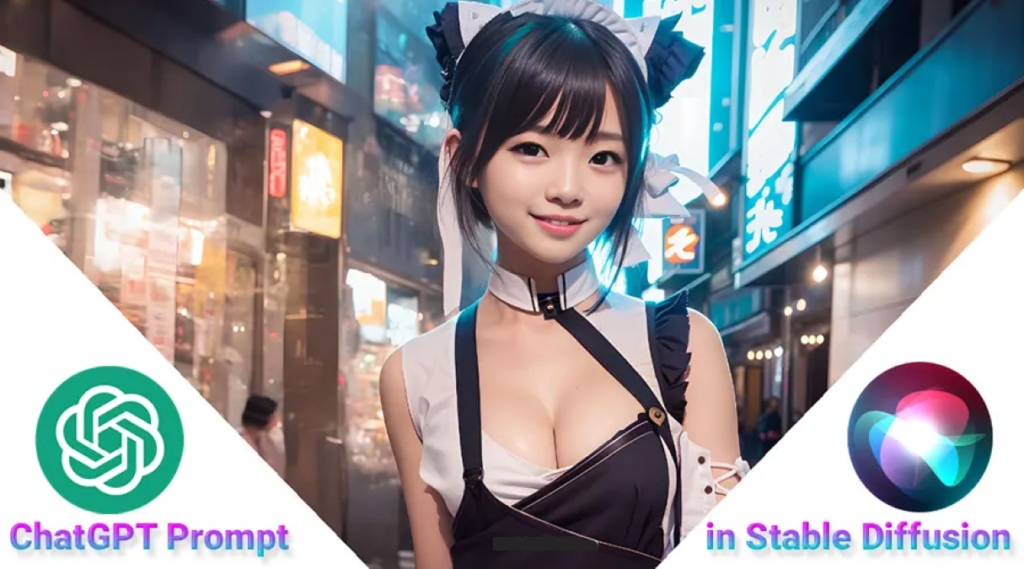
You’re probably familiar with two of the most powerful AI tools today, ChatGPT and Stable Diffusion. ChatGPT has excellent natural language processing capabilities, supporting text queries and communication. Meanwhile, Stable Diffusion is a tool that creates perfect AI images from text. So why not combine the two to make your work easier?
Introduction
The guide on using ChatGPT to create effective prompts in Stable Diffusion is essential for those new to AI. Prompts created by ChatGPT can be used to enhance Stable Diffusion’s processing abilities. With the support of ChatGPT, you can quickly and easily create effective prompts, and use them to generate creative AI images in Stable Diffusion.
What is ChatGPT?
ChatGPT is a natural language processing (NLP) system based on the Transformer architecture and developed by OpenAI. GPT stands for “Generative Pre-trained Transformer,” a pre-trained deep learning model architecture used to generate text.
ChatGPT uses a deep learning model to process and automatically generate responses to user queries or suggestions. With its unique natural language processing abilities, ChatGPT can support various applications, including chatbots, text summarization, translation, and many more.
ChatGPT is one of the most advanced technologies in the field of natural language processing and is widely used in AI and NLP applications today.
What is Stable Diffusion?
However, ChatGPT has no information about Stable Diffusion since its database was only updated until 2021, while Stable Diffusion was launched in 2022.
According to Wikipedia, Stable Diffusion is an open-source machine learning model that can create images from text, modify images based on text prompts, or fill in details on low-resolution or low-detail images. It has been trained on billions of images. It was developed by Stability AI and publicly released on August 22, 2022.
Why should we combine ChatGPT and Stable Diffusion to create high-quality AI images?
As introduced above, ChatGPT is a text processing tool that contains a vast database of language such as words, sentences, etc. in natural language. This is necessary to create high-quality prompt data as input for Stable Diffusion. Meanwhile, the SD tool is trained with a rich dataset of images, but it can only create AI images with the most accurate prompt commands. Otherwise, it will be a mess of data. Combining ChatGPT and Stable Diffusion to create high-quality AI images is a great idea because both technologies have unique advantages and capabilities in the field of artificial intelligence. When combining ChatGPT and Stable Diffusion, we can leverage the natural language processing capabilities of ChatGPT to provide requests or proposals for the images we want to create. Then, Stable Diffusion will use techniques and algorithms to create high-quality AI images based on our requests.
How to use ChatGPT to create effective prompts for Stable Diffusion
Using ChatGPT:
To start using ChatGPT, sign up for a free account and then access chat.openai.com. Enter a question or prompt in the input box at the bottom to start the conversation.
You may consider upgrading to the ChatGPT Plus version for $20/month to get updated data and more accurate and natural language processing capabilities.
Using Stable Diffusion:
Stable Diffusion is a completely free and open-source AI tool. You can download and install it on your personal computer, or use the online version with the SD Google Colab. After installation, open the application and go to the GUI interface to enter the prompt.
Enter the prompt generated from ChatGPT and customize the parameters, then click the Generate button to get your AI image.
How to request ChatGPT to create effective prompts for Stable Diffusion
1.Portrait image description
There are three important techniques to provide high-quality prompts for Stable Diffusion from ChatGPT:
- Specify image style: You need to request a specific type of image. For example, requesting “close-up illustration, realistic image”.
- Request specific subject: For example, the name of a specific character like actress “Ana de Armas”. If the topic is not fixed, ChatGPT will use a different actress in each prompt. Style and elements can be easily changed because of that.
- Request to create multiple variations: Request two example prompts.
Now, combine these together, and you will create a request for ChatGPT.
Example: Write a high-quality prompt for a beautiful close-up portrait of Ana de Armas, used for text-to-image models (Stable Diffusion, mid-journey, or Dalle2). The result is:
- portrait of beautiful happy young ana de armas, ethereal, realistic anime, trending on pixiv, detailed, clean lines, sharp lines, crisp lines, award-winning illustration, masterpiece, 4k, eugene de blaas and ross tran, vibrant color scheme, intricately detailed
- Alberto Seveso and Geo2099 style, A highly detailed and hyper-realistic portrait of a gorgeous young Ana de Armas, Lisa Frank, trending on ArtStation, butterflies, floral, sharp focus, studio photo, intricate details, highly detailed, by Tvera and Wlop and Artgerm
Request: ChatGPT provides more examples. ChatGPT will respond with:
- A stunning close-up illustration of Ana de Armas in a dramatic, dark and moody style, inspired by the work of Simon Stålenhag, with intricate details and a sense of mystery.
- A photorealistic, highly detailed illustration of Ana de Armas in a vintage Hollywood style, reminiscent of the golden age of cinema, with a focus on glamour and elegance.
- A close-up illustration of Ana de Armas in a neo-noir style, reminiscent of the film noir genre, with a focus on shadows, contrasts, and a sense of danger.
Next, use these prompts in Stable Diffusion with negative prompts like below: - ugly, tiling, poorly drawn hands, poorly drawn feet, poorly drawn face, out of frame, extra limbs, disfigured, deformed, body out of frame, bad anatomy, watermark, signature, cut off, low contrast, underexposed, overexposed, bad art, beginner, amateur, distorted face
ChatGPT Prompt #1: A stunning close-up illustration of Ana de Armas in a dramatic, dark and moody style, inspired by the work of Simon Stålenhag, with intricate details and a sense of mystery.
ChatGPT Prompt #2: A photorealistic, highly detailed illustration of Ana de Armas in a vintage Hollywood style, reminiscent of the golden age of cinema, with a focus on glamour and elegance.
ChatGPT Prompt #3: A close-up illustration of Ana de Armas in a neo-noir style, reminiscent of the film noir genre, with a focus on shadows, contrasts, and a sense of danger.
At this point, you have seen the powerful creativity between ChatGPT’s prompts and the AI image creation tool, Stable Diffusion. Next, here’s another image description below.
2.Full Body Description:
Now, let’s refine the request for ChatGPT to provide prompts for full-body portrait images. All you need to do is add the phrase “full-body” to your prompt and provide examples.
For example: write a high-quality prompt for a full-body portrait, based on the beautiful and realistic image of Ana de Armas, for text-to-image conversion models such as Stable Diffusion, Midjourney, or Dalle2. The result is:
- Full-body portrait of beautiful happy young Ana de Armas, ethereal, realistic anime, trending on Pixiv, detailed, clean lines, sharp lines, crisp lines, award-winning illustration, masterpiece, 4K, Eugene de Blaas and Ross Tran, vibrant color scheme, intricately detailed
- Full-body portrait of a gorgeous young Ana de Armas, a highly detailed and hyper-realistic Lisa Frank, trending on ArtStation, butterflies, floral, sharp focus, studio photo, intricate details, highly detailed, by Tvera and Wlop and Artgerm, Alberto Seveso and Geo2099 style,
Provide more examples:
ChatGPT Prompt #4: Full body illustration of Ana de Armas in a stunning red dress, posing elegantly against a beautiful sunset background, with realistic lighting and shadows, by a master digital artist known for their photorealistic style, such as Jomaro Kindred or Gleb Alexandrov
ChatGPT Prompt #5: A full body illustration of Ana de Armas as a powerful warrior queen, with intricate armor and weapons, in a dynamic and action-packed pose, rendered in a highly detailed and photorealistic style by top fantasy artists such as Simon Stålenhag or Jora Vision
ChatGPT Prompt #6: A full body illustration of Ana de Armas as a sultry and mysterious sorceress, with detailed and realistic clothing and accessories, in a dramatic and captivating pose, by leading fantasy and sci-fi artists such as Yoshitaka Amano or Dave Rapoza.
Requests based on ChatGPT results:
If you find a specific prompt that ChatGPT provides to be suitable, you can request it to provide more variations by saying: “I like the third one. Can you give me more examples like that?” ChatGPT will provide you with many variations of the same style. From there, you can create many images of this style and choose the best one.
Conclusion:
Combining ChatGPT and Stable Diffusion is an effective way to create high-quality AI images with high accuracy and resolution. Using ChatGPT to create prompts and request Stable Diffusion saves time and effort in creating new AI applications.
